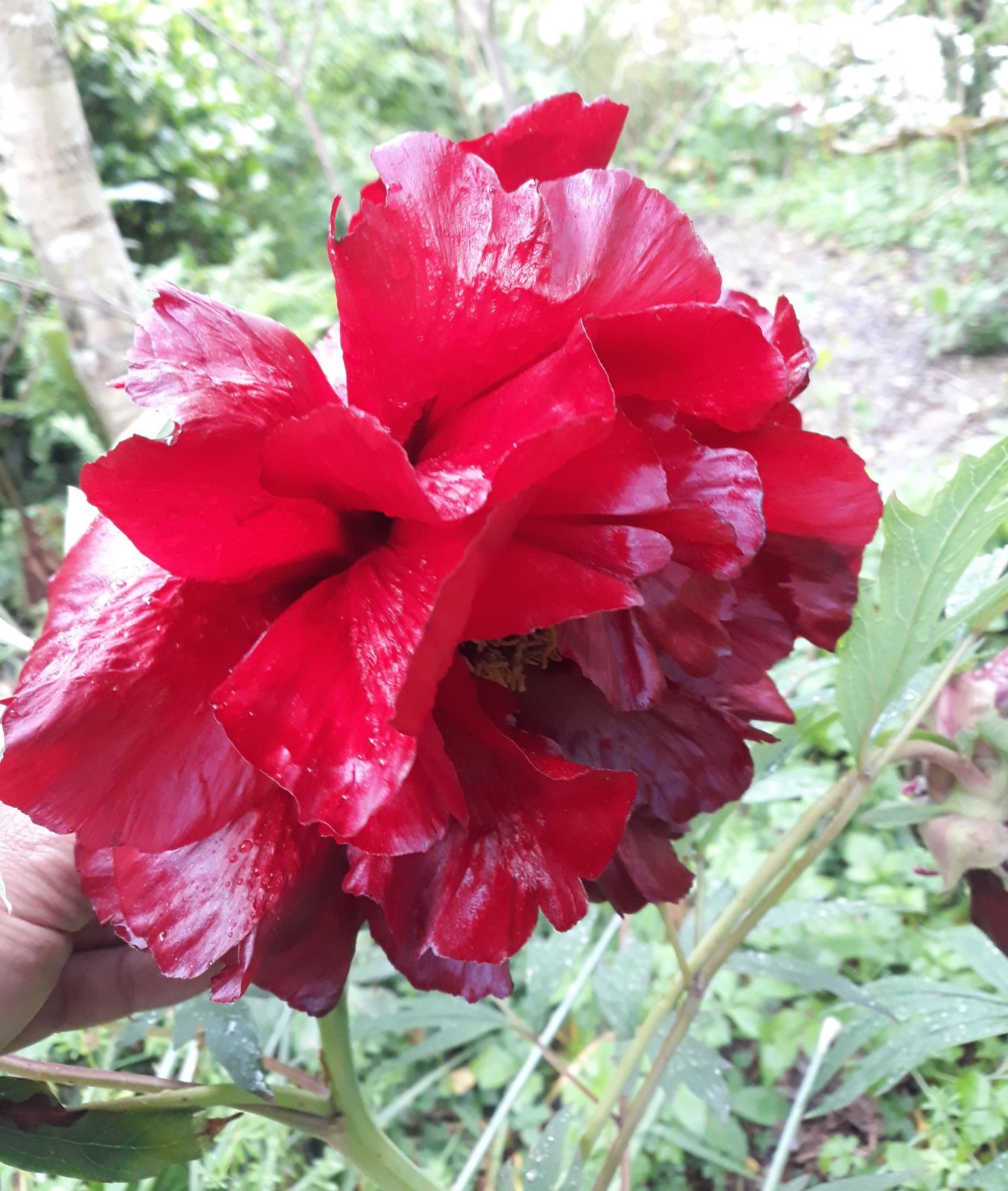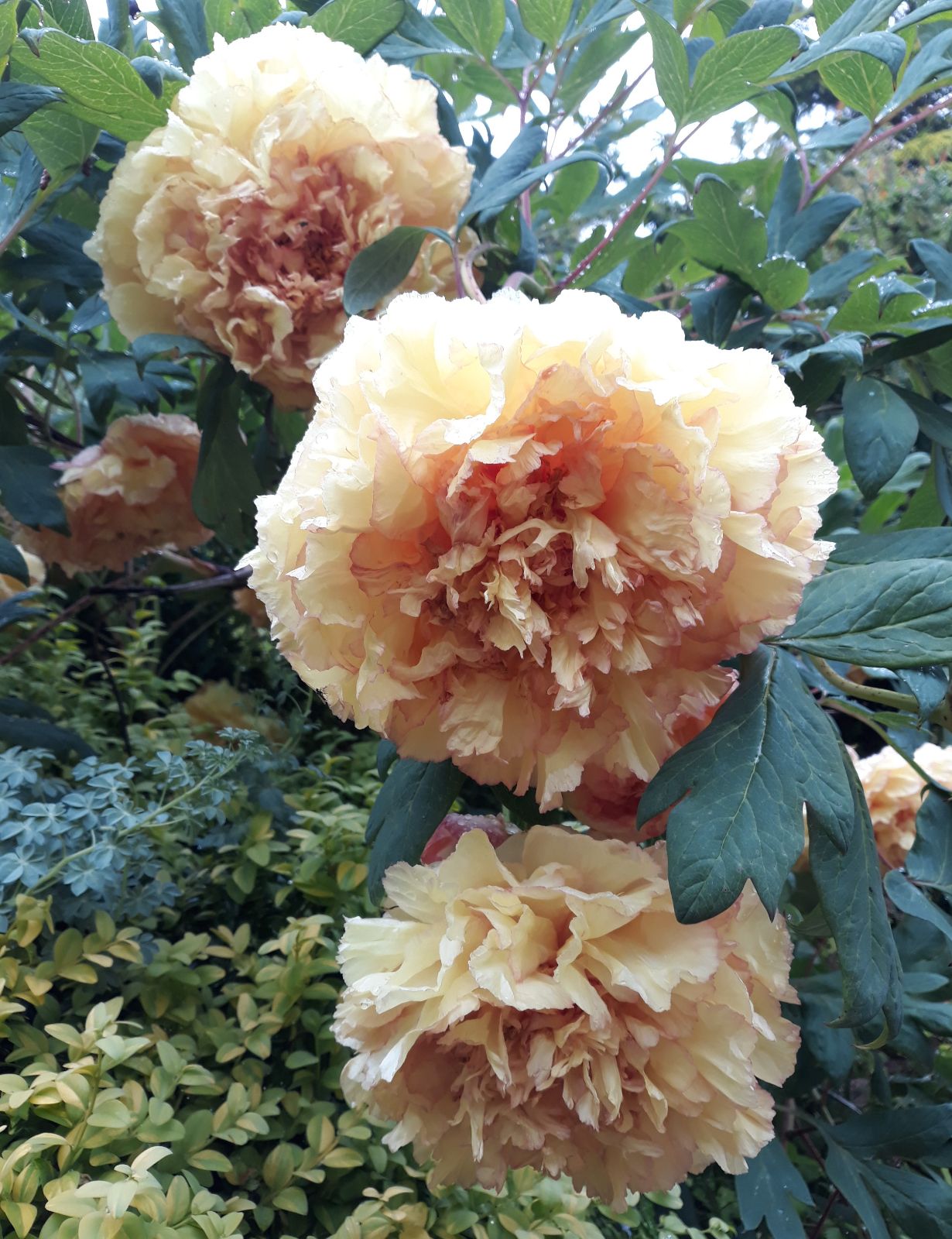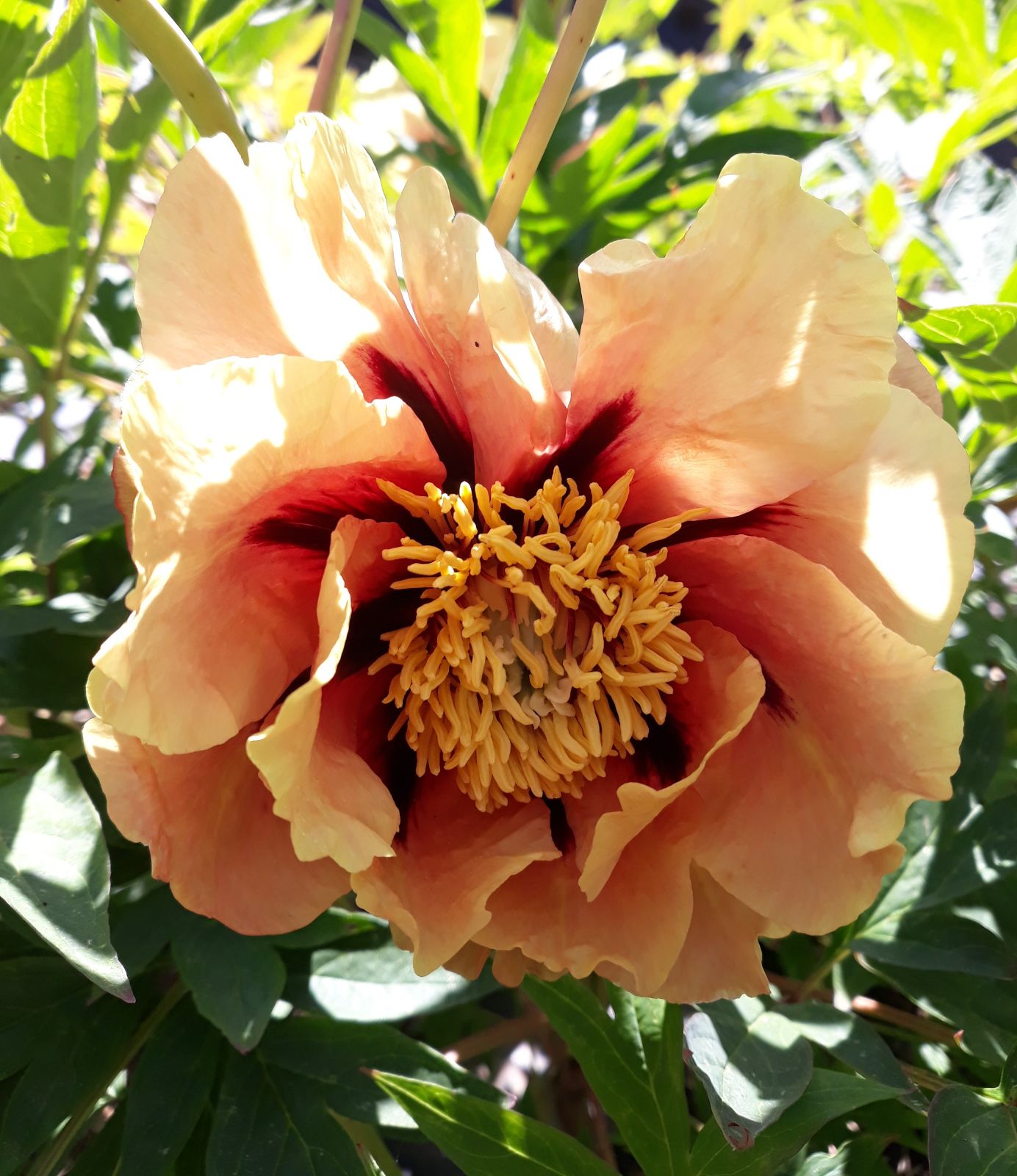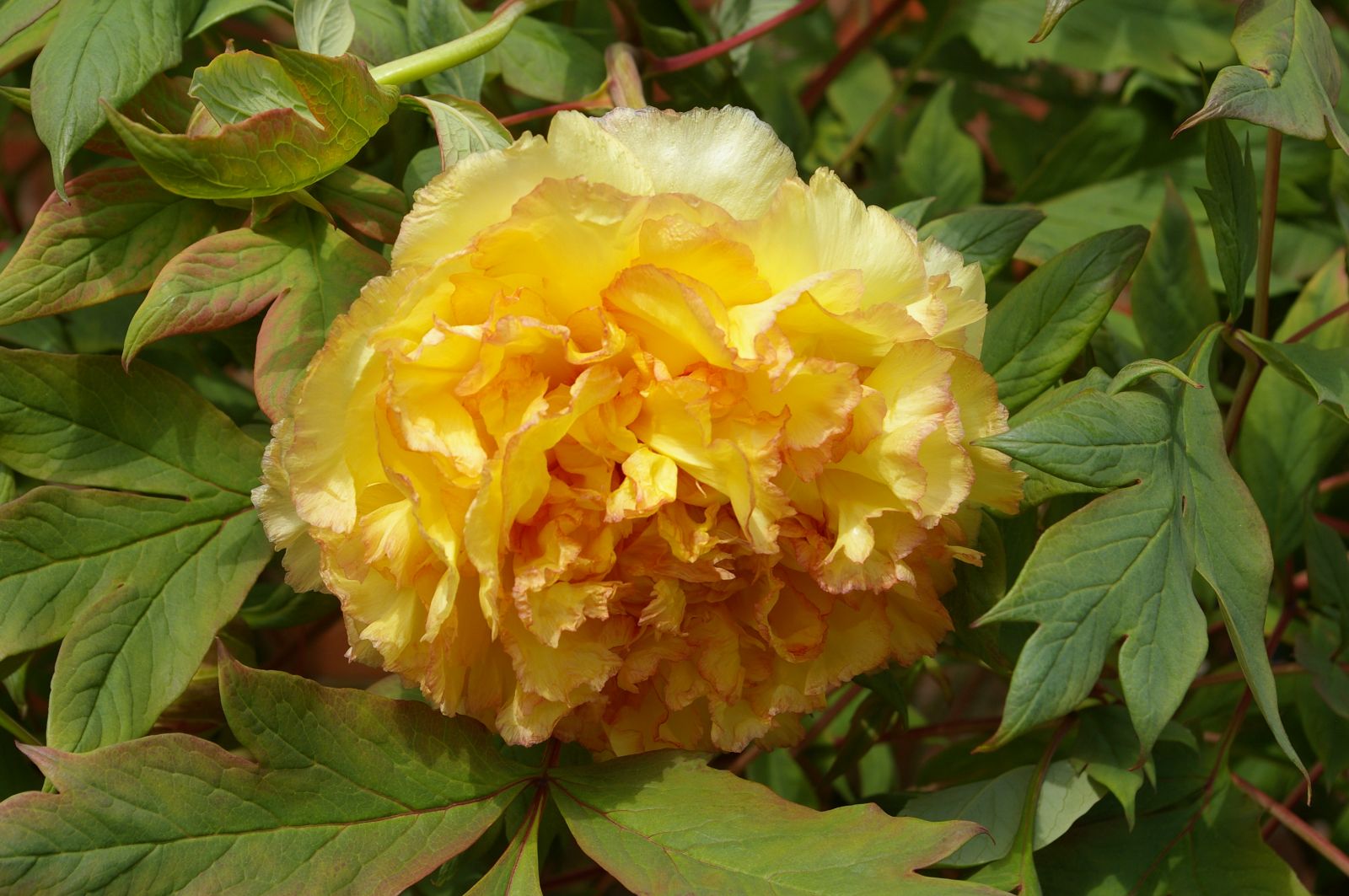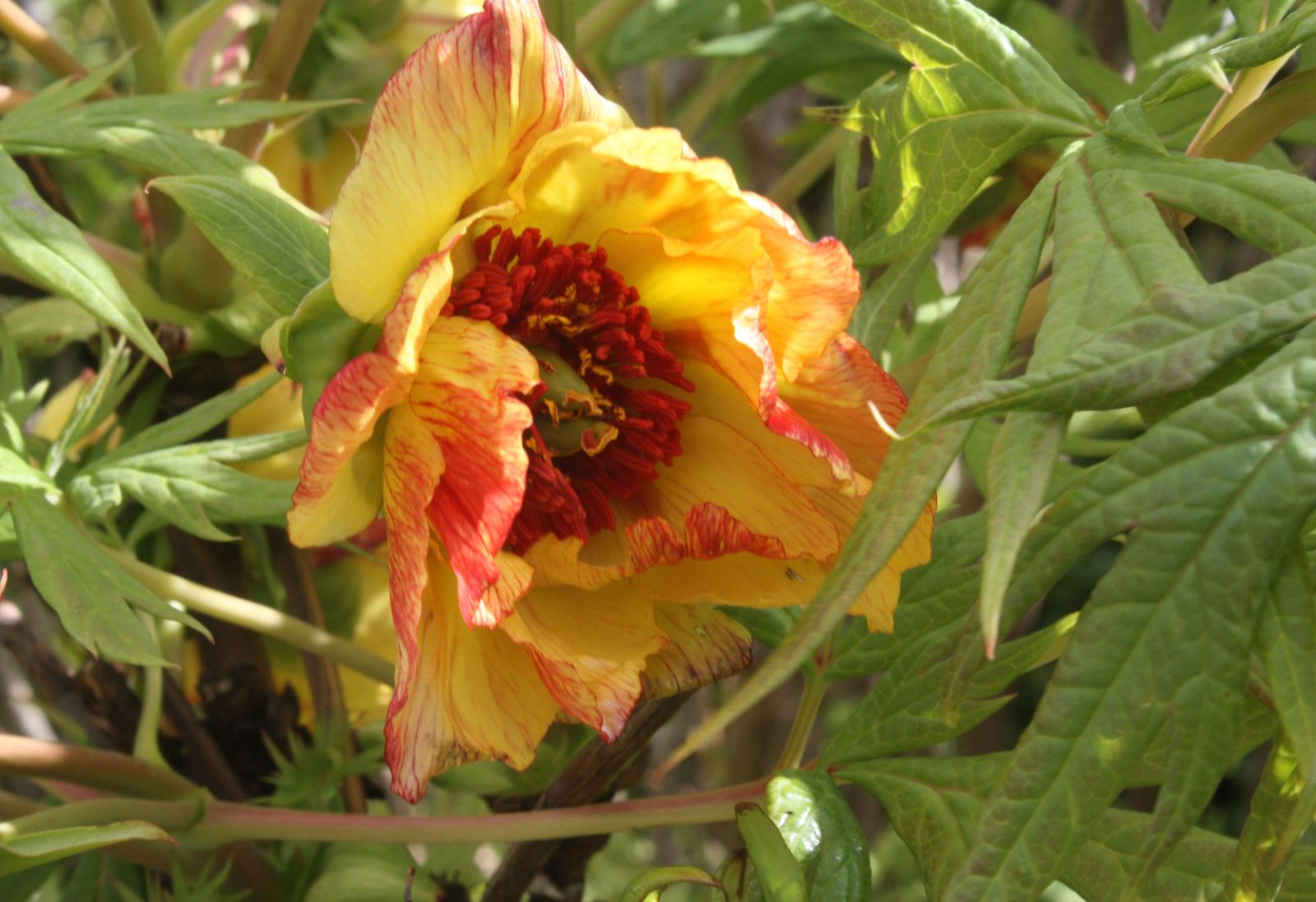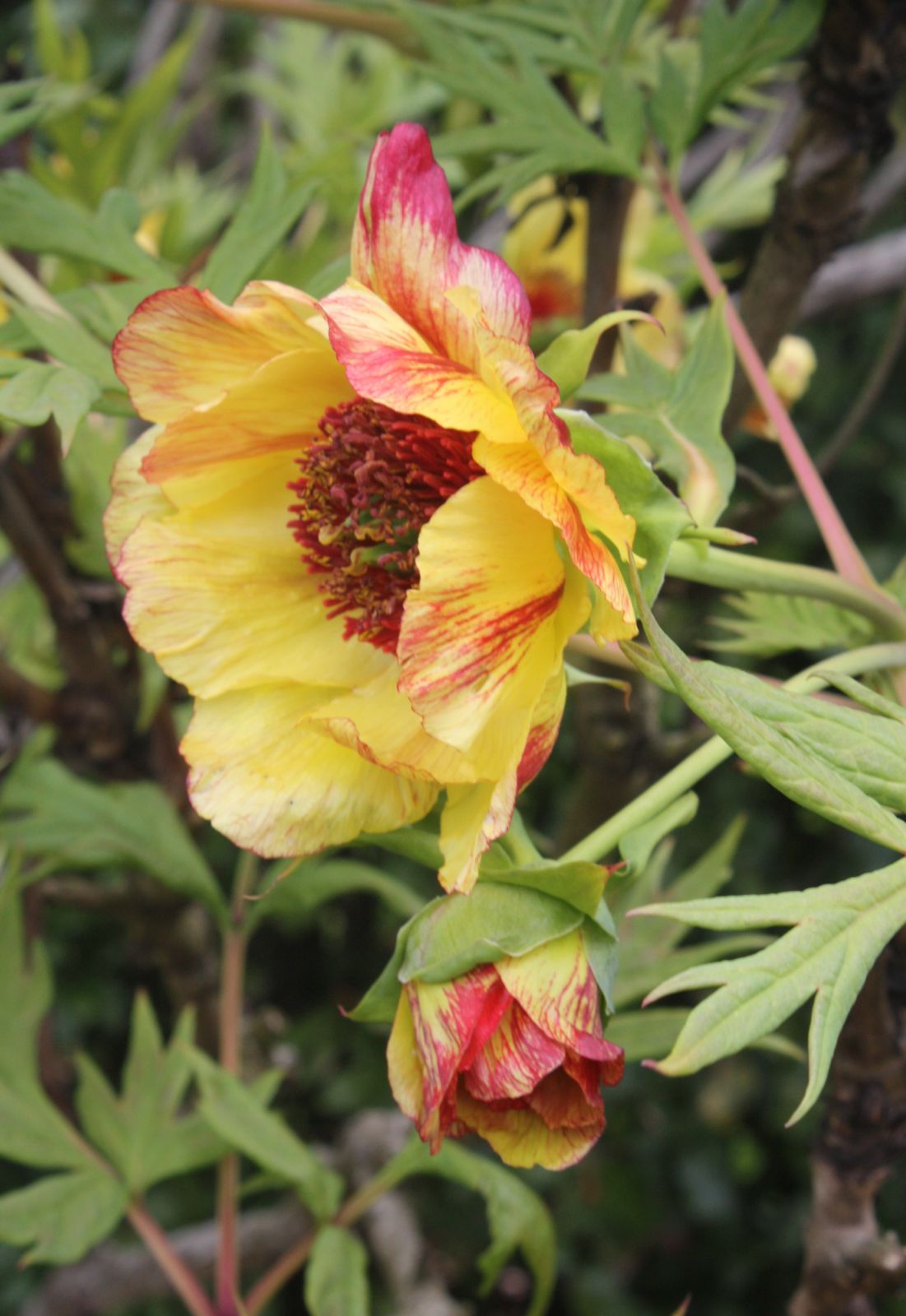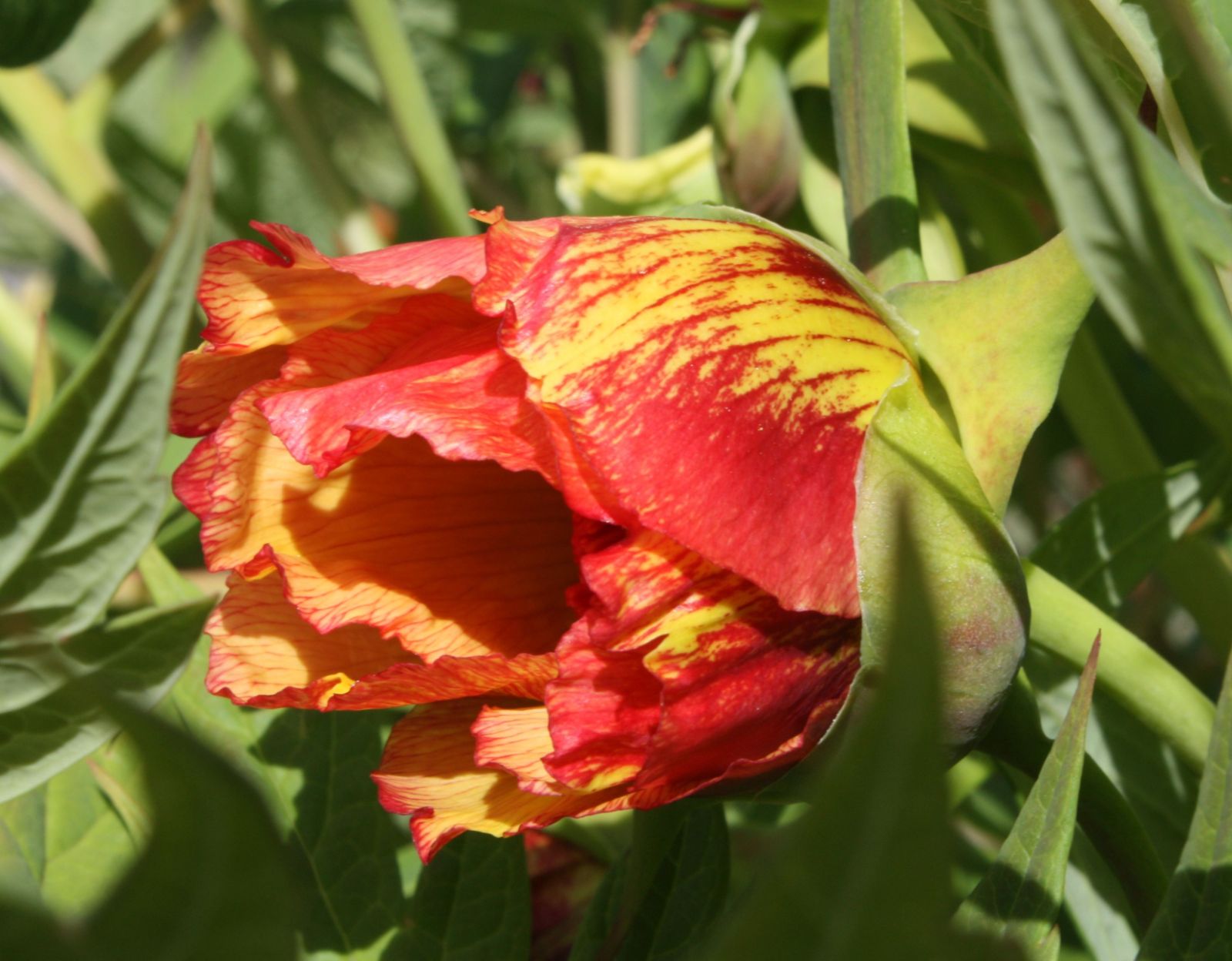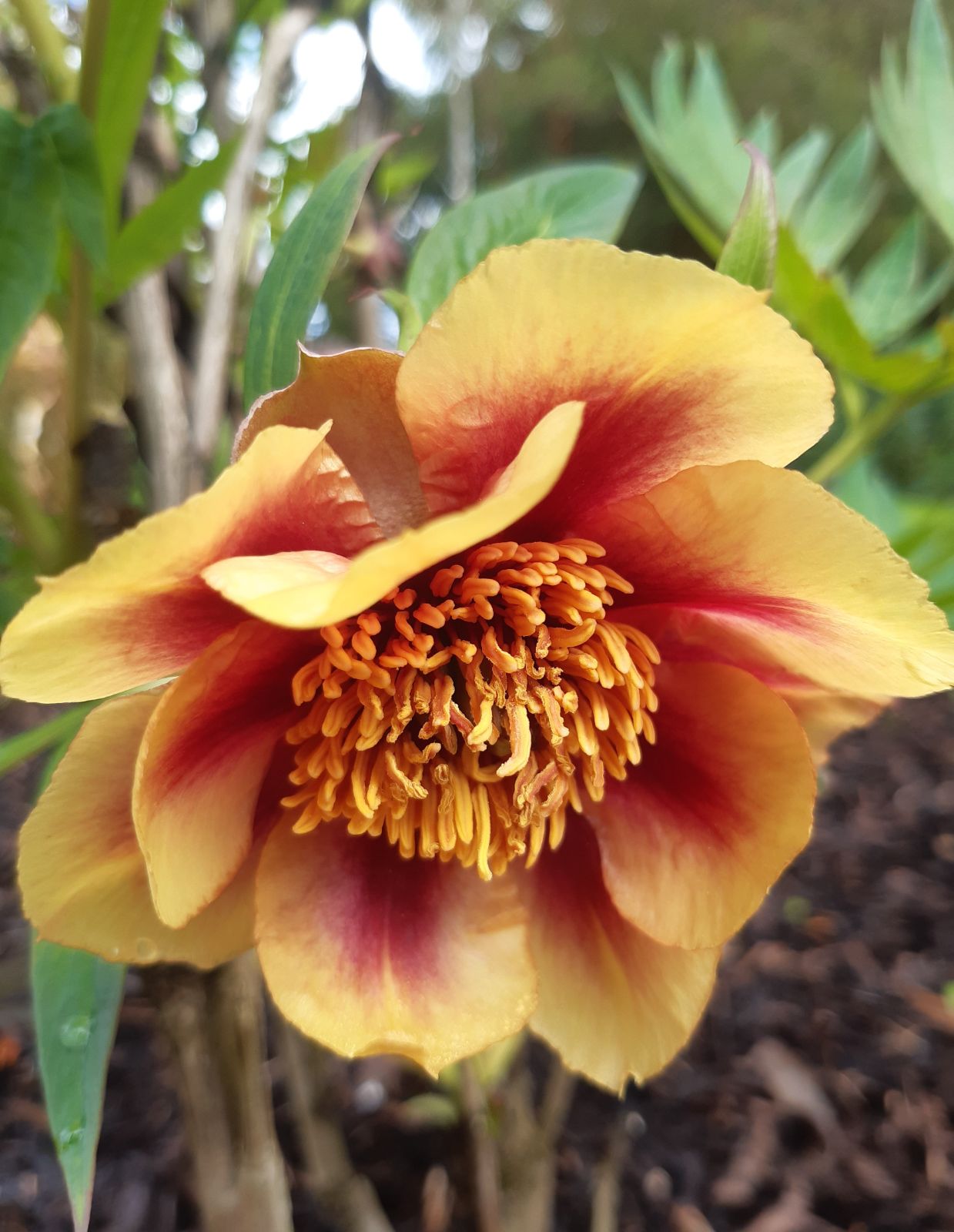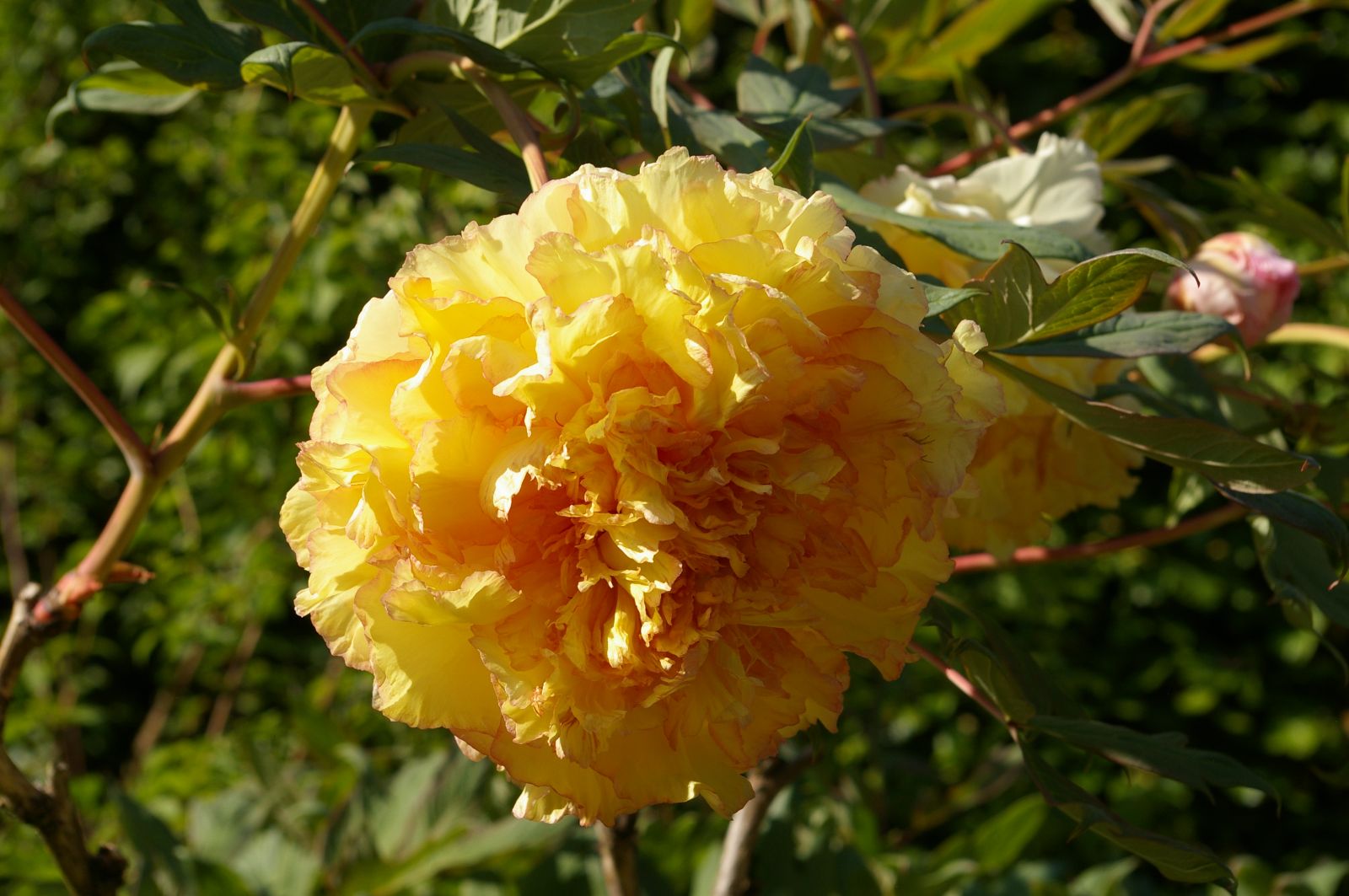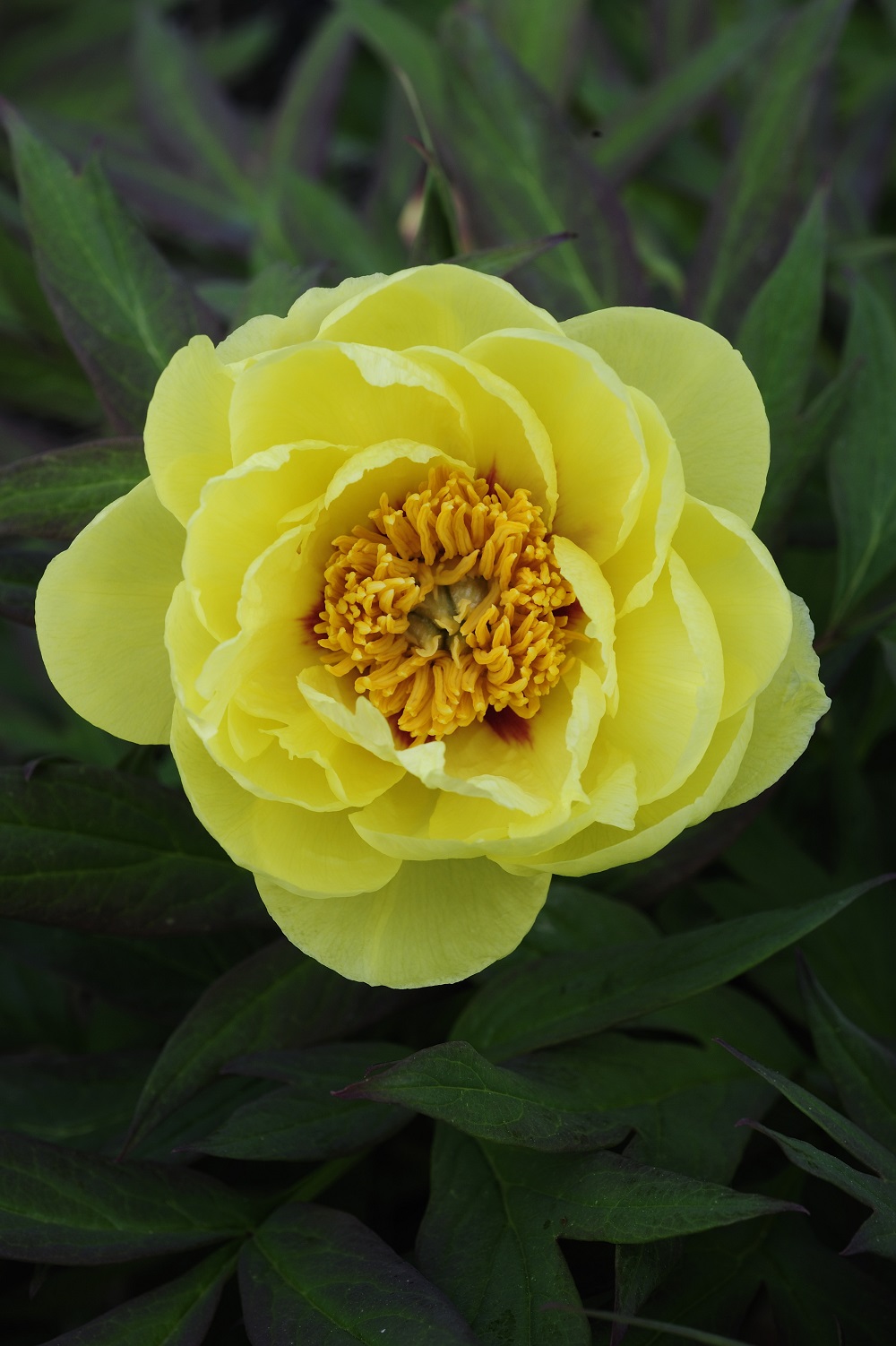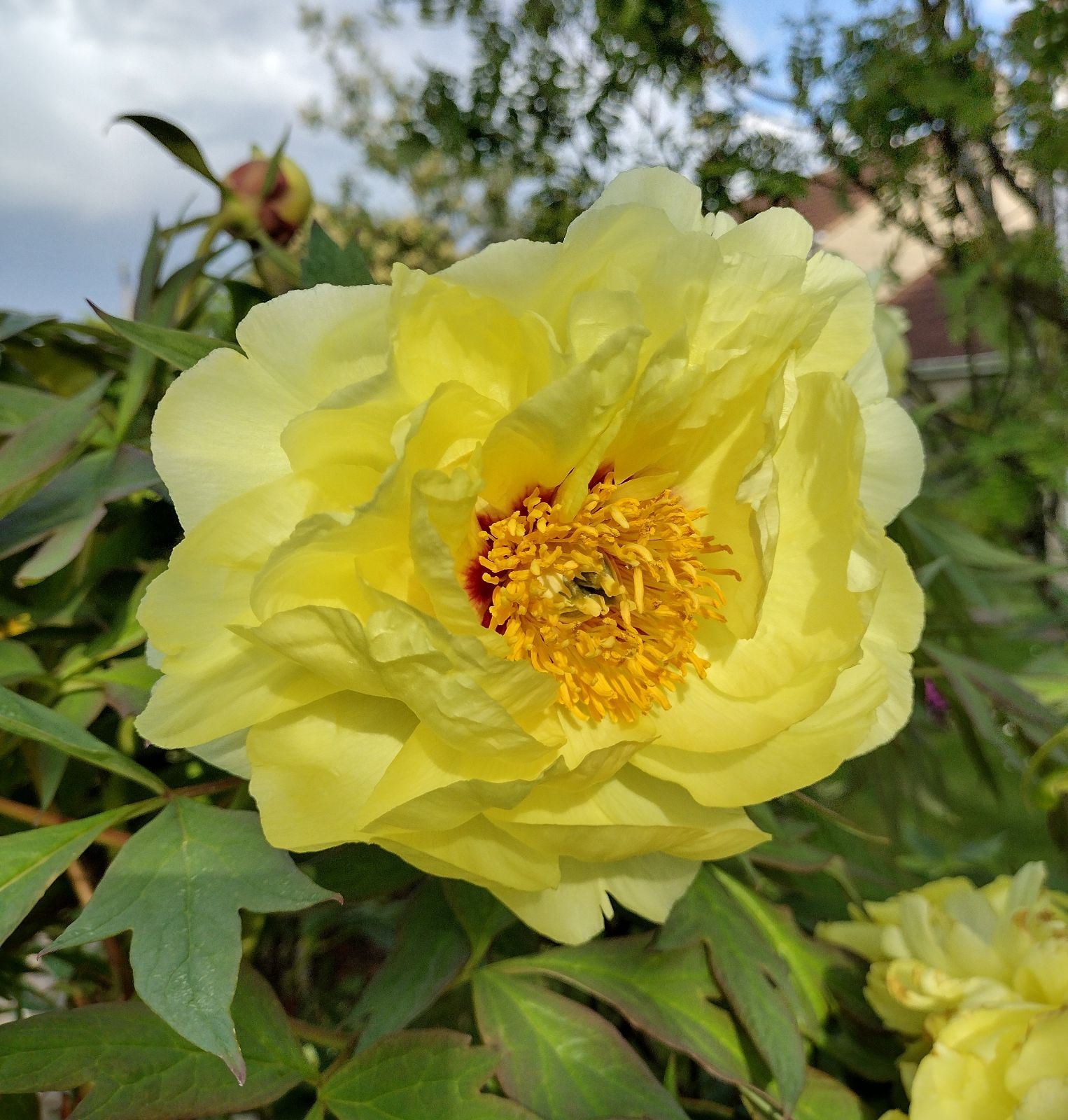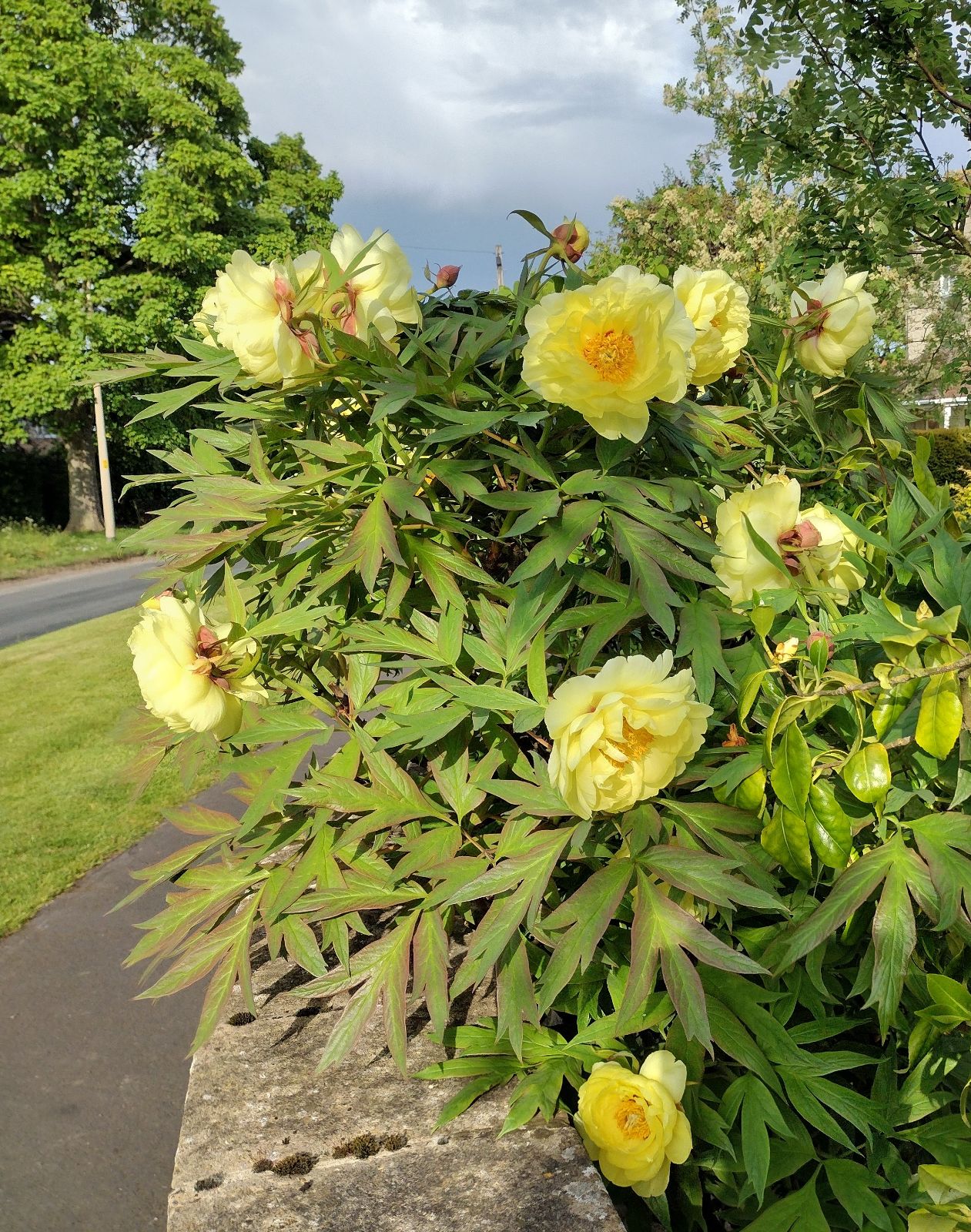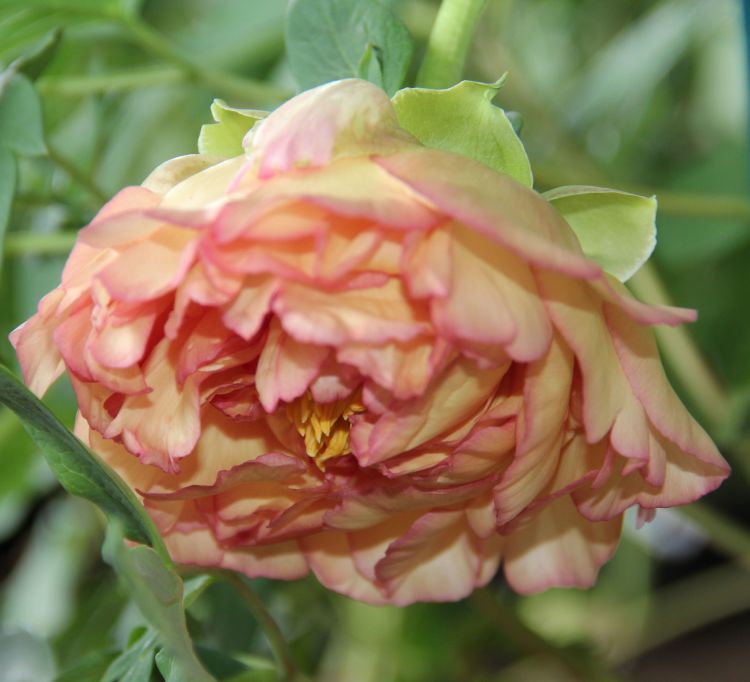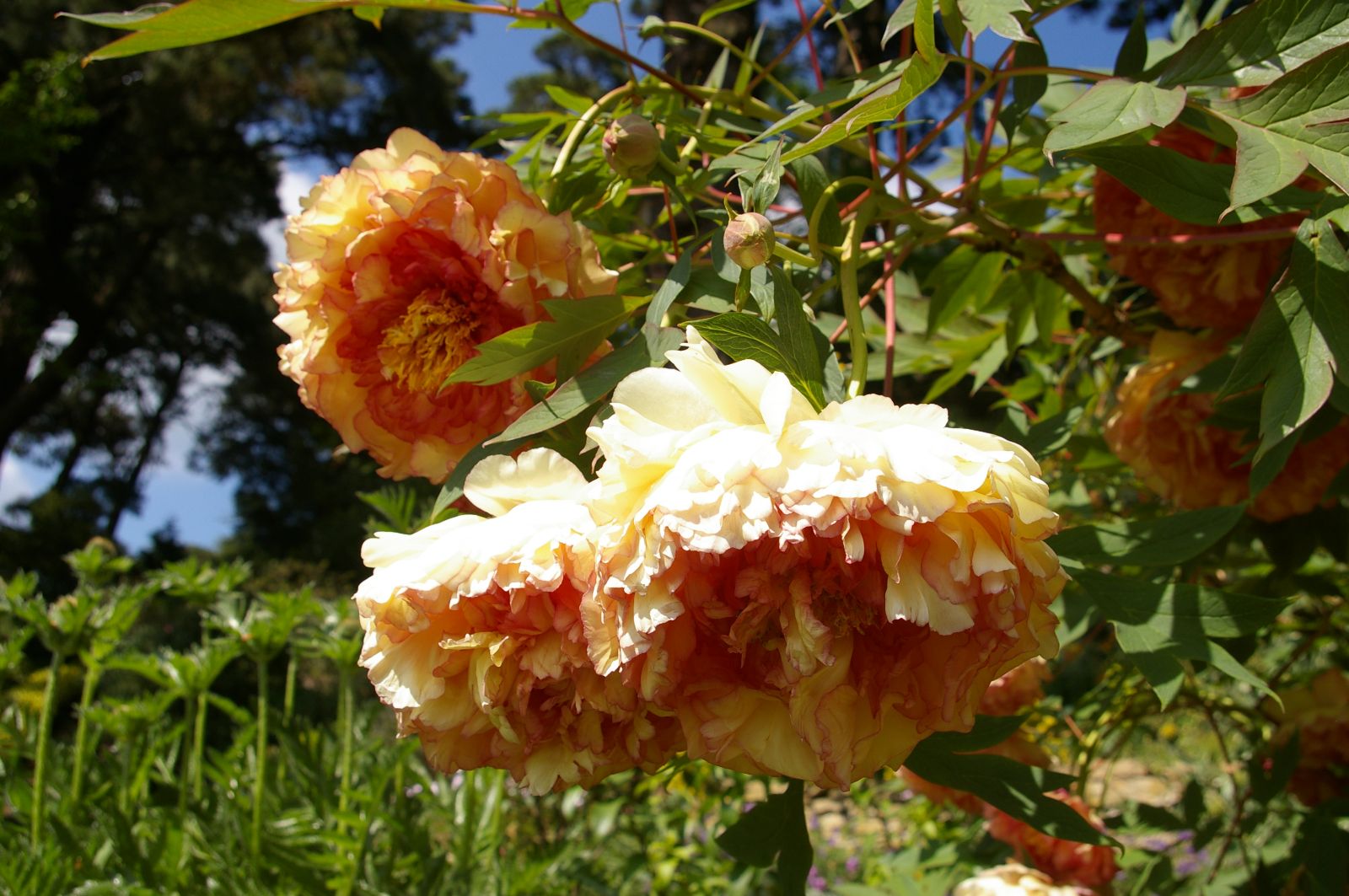Paeonia Lutea Hybrids
Sponsor
Kindly sponsored by
Sponsored by David Sayers in memory of Hedvika Fraser.
Credits
Julian Sutton (2020)
Recommended citation
Sutton, J. (2020), 'Paeonia Lutea Hybrids' from the website Trees and Shrubs Online (treesandshrubsonline.
Genus
Synonyms
- Paeonia × lemoinei Rehd.
Infraspecifics
Other taxa in genus
- Paeonia cathayana
- Paeonia Central Plains Cultivars
- Paeonia decomposita
- Paeonia delavayi
- Paeonia Gansu Cultivars
- Paeonia Itoh Cultivars
- Paeonia Japanese Cultivars
- Paeonia jishanensis
- Paeonia × lemoinei
- Paeonia ludlowii
- Paeonia ostii
- Paeonia Other Shrubby Hybrids
- Paeonia qiui
- Paeonia rockii
- Paeonia rotundiloba
- Paeonia Southern Yangtze Cultivars
- Paeonia Southwest Cultivars
- Paeonia × suffruticosa
This punchy term covers all hybrids involving any colour form of Paeonia delavayi. Initially confusing, it reflects the fact that yellow flowered P. delavayi f. lutea (once called P. lutea) was both the first and the most common form used by breeders. The American Peony Society (the international cultivar registration authority for Paeonia) use the term in this sense, and there appears to be no ambiguity in contemporary usage.
Paeonia delavayi is not a traditional ornamental in Chinese gardens, and seems not to have contributed to the various classes of hybrids in China. Since about 1900, however, it has been an important parent of hybrids with other woody peonies, to some extent in Europe and especially in North America. These hybrids’ great virtue is garden vigour, in part due to the capacity of P. delavayi for underground spread, and they are widely suited to our area. Novel and subtle colours are common where yellow flowered f. lutea is used along with a pink/purple/red parent (Burkhardt 2020). F1 hybrids are sterile or have very low fertility; most have hanging or outfacing flowers. Only relatively recently have further generations been bred; such ‘advanced generation’ hybrids have potential for greater hardiness and upfacing flowers.
P. delavayi hybrids have several distinct origins; the second (American) group is by far the most significant.
The earliest group originated in France. P. delavayi f. lutea came into cultivation towards the end of the 19th century, as seed sent from Yunnan by Delavay. Once it had flowered, it was soon crossed with Chinese mudan, at the Lemoine nursery, Nancy, and by Louis Henry at the Jardin des Plantes in Paris. The mudan parents were almost certainly either Central Plains varieties or European-raised seedlings derived from them (Cheng 2007; Bremer 2019). Flowers are frequently large, to 20 cm across, and range from singles to full, heavy doubles; they tend to hang amongst the leaves, especially the doubles such as Henry’s ‘Souvenir de Maxime Cornu’. The ground colour is usually yellow, variously flushed or edged with redder tones. They tend to be later flowering, May–June in Britain. These can be widely spreading, floriferous plants: a thirty year old specimen of Lemoine’s ‘L’Espérance’ grown in Somerset, UK, was 1.2 m tall and 1.5 m wide, carrying 80 to 150 flowers each year (Kelway 1954). They are well suited to much of western Europe, but are too tender for colder central parts of North America (Bremer 2019); several are still in commerce. The name P. × lemoinei was published for this group of hybrids (Rehder 1920) but we do not find this a helpful concept (for reasoning see P. × lemoinei). Rather later, Lemoine raised some important hybrids between P. delavayi f. lutea and a Japanese cultivar, ‘Yaso-okina’; three were introduced from 1935 onwards, ‘Alice Harding’, ‘Eldorado’ and ‘Mine d’Or’. They are more or less semi-double, with flowers generally more outfacing than hanging (Burkhardt 2020). These novel hybrids were not universally appreciated, however. Wister (1946) commented that ‘Souvenir de Maxime Cornu’ ‘looks much more like a dahlia than a peony, and I do not care much for it’. Yet another, much later French introduction, something of a one-off but with rather similar parentage, is Jean Cayeux’s ‘Hélène Martin’ (see below).
A second group arose quite independently in North America. Between about 1915 and 1953 Professor Saunders, a chemistry academic of Clinton, New York, whose given name Albert was apparently rarely used in gardening circles, raised numerous hybrids among both herbaceous and woody species (Wister 1962). Relevant here are his hybrids using P. delavayi as the seed parent, both yellow and red/pink flowered forms, and Japanese botan cultivars as pollen parents. Despite being highly selective of seedlings, Saunders introduced about 75 single and semi-double cultivars, all F1 hybrids, in a much wider range of colours than had been achieved in France, where only yellow-flowered P. delavayi had been used. Like the French varieties, the flowers tend not to be held upright (Bremer 2019). Many are still commercially available in North America; some such as ‘Argosy’, ‘Black Pirate’ and ‘High Noon’ were also distributed in Europe.
Saunders understood that to achieve hardier plants with flowers held upright, breeding had to be continued through further generations. While most of his F1s were sterile, two unregistered seedlings were not (others have since been recognised). The Greek-American artist Nassos Daphnis worked with these over many years, mainly backcrossing to Japanese cultivars, to produce a series of advanced generation hybrids with upright flowers and much higher fertility, which could then be the basis of ongoing breeding; 46 were named (Bremer 2019). Most carry the names of characters from Greek myth; many, such as ‘Hephestos’ have proved popular garden plants, especially in North America. Other American breeders such as Michigan vet David Reath, continued work with this group. Hybrids of this American lineage, both F1 and advanced generation hybrids, have been the main woody parents of the Itoh hybrids (q.v.). In Australia, Bernard & Lucy Chow of Melbourne have also crossed advanced generation hybrids to good effect, both amongst themselves and with Japanese cultivars, in particular extending the colour range towards orange (Chow & Chow 2018).
Thirdly, there are a very few hybrids between P. delavayi and P. ludlowii, notably the Irish ‘Anne Rosse’ involving a red-flowered delavayi (Adams 2010); ‘Derek Hill’ probably shares this origin (Tobin 2015), and other contemporary breeders have noted similar seedlings (Burkhardt 2008). It seems likely that P. delavayi rather than P. ludlowii has been used in Western hybrids with Chinese and Japanese cultivars because of both its earlier introduction and the rarity of P. ludlowii in North America.
We list a representative selection of better-known cultivars. For fuller listings see American Peony Society (2020) and specialist nurseries such as Solaris Farms (2020) and Pivoines Rivière (2020).
'Alice Harding'
Synonyms / alternative names
Kinko
Clear yellow with small, largely hidden, red basal marks; a rather full, nodding, lightly fragrant semi-double; dense but tending to be low-growing. Parents P. delavayi f. lutea and a Japanese cultivar, ‘Yaso-okina’; bred at the Lemoine nursery, France, introduced 1935. The Japanese trade designation Kinko was first applied in the 1939 Wada nursery catalogue (American Peony Society 2020; Pivoines Rivière 2020). Alice Harding was a New Jersey plantswoman and peony enthusiast of the early 20th century. Her European contacts included Émile Lemoine, who also named a lilac, an iris and – regrettably – another peony (a double white herbaceous cultivar) in her honour (Whitehead 2000). This ‘Alice Harding’ was the first woody parent of the Itoh Hybrids.
'Anne Rosse'
Bright yellow, heavily streaked red on both surfaces; outfacing, single flowers, smaller than those with Japanese or Central Plains hybrids in their background but as expected from the parentage they tend to be somewhat concealed in the foliage; a tall plant, approaching 5 m in height and over time forming a broad bush. Parents P. ludlowii and red-flowered P. delavayi; raised by the 6th Earl of Rosse at Birr Castle, Ireland, in the mid-20th century. There are good examples at both Birr Castle and Glasnevin, but it is not common outside Ireland. (Nelson 2000, Adams 2010;Tobin 2015). Also Irish, ‘Derek Hill’ is similar but was raised by the artist Derek Hill at his garden in County Donegal, prior to 1978 (Nelson 2000).
'Black Pirate'
Dark red petals darkening further with age, with a black basal flare and very dark filaments; outfacing semi-double with 3–4 whorls of petals, normally only one flower per shoot (American Peony Society 2020; Pivoines Rivière 2020). A Saunders hybrid registered in 1935; parents red P. delavayi and a cherry-red Japanese cultivar (Burkhardt 2020). ‘Thunderbolt’ is similar, but has narrower leaf divisions (American Peony Society 2020).
'Center Stage'
Cream fading to white, with conspicuous purple flares; single. Relatively late flowering, around 1 m tall, with one flower per shoot, and good resistance to botrytis. A Reath hybrid of unknown parentage, registered in 2000 (American Peony Society 2020; Warmerdam Paeonia 2020).
'Chromatella'
A sport from ‘Souvenir de Maxime Cornu’ with the same large, double, fragrant flowers, introduced by Lemoine in 1928. Older accounts describe it as being sulphur-yellow (see Burkhardt 2020, Bean 1976) but as seen today at least some of the orange/salmon shading is still apparent.
'Flambeau'
Carmine red; a very full double with flowers tending to hang among the leaves; plant very leafy, to 1.5 m. Exact parentage unknown; bred by Lemoine, introduced 1930. (American Peony Society 2020; Pivoines Rivière 2020). Not common, but still available commercially in Europe.
'Hélène Martin'
White, tinged greenish or yellowish in places, with a diffuse reddish basal zone; very large, semi-erect, single flowers. A tall and vigorous plant which can exceed 1.8 m in height. Parents a plant labelled P. potaninii trolloides (see discussion under P. delavayi) and the Japanese ‘Gessekai’; raised by French nurseryman and iris breeder Jean Cayeux, 1986 (Burkhardt 2020; Pivoines Rivière 2020).
'Hephestos'
Dark red semi-double, sometimes approaching full double on a mature plant; flowers upfacing, large (to 22 cm diameter), normally one per shoot. A Daphnis hybrid registered in 1977, from a cross between two Saunders hybrids, ‘Thunderbolt’ and the un-named F2-A (American Peony Society 2020; Pivoines Rivière 2020; Warmerdam Paeonia 2020). Hephestos (other spellings exist) was the ancient Greek god of fire and metalworking.
'High Noon'
Synonyms / alternative names
Paeonia Lutea Hybrids Hainun
Paeonia Lutea Hybrids Hai Huang
Clear yellow with small red basal patch; a semi-double, sometimes rather irregular, the flowers held upright, above the foliage; plant tall, sometimes approaching 2 m, and known for reblooming in late summer. A Saunders hybrid registered in 1952; precise parentage unknown (American Peony Society 2020; Pivoines Rivière 2020; Warmerdam Paeonia 2020). Highly successful and widely distributed in North America, Europe and East Asia. The curious trade designation Hainun is sometimes seen; it seems be a romanized form of a Japanese homophone. It is sometimes offered by Chinese nurseries as Hai Huang.
'L'Espérance'
Synonyms / alternative names
Kintei
Amber-yellow with conspicuous red basal spot; petals in two whorls; plant to 1.5 m tall and wide. Parents P. delavayi f. lutea and (probably) a Central Plains cultivar; bred by Lemoine and first offered in 1909–1910. The Japanese trade designation Kintei was first applied in the 1939 Wada nursery catalogue (Kelway 1954; Bean 1976; American Peony Society 2020; Pivoines Rivière 2020).
'Souvenir de Maxime Cornu'
Synonyms / alternative names
Paeonia Lutea Hybrids ‘Souvenir du Professeur Maxime Cornu’
Paeonia Lutea Hybrids Kin-kaku
Light-yellow edged and shaded orange/salmon; a large (to 18 cm diameter), hanging, very fragrant, full double; plant 1.5 m or more in height. Parents P. delavayi f. lutea and (probably) a Central Plains cultivar; selected by Louis Henry around 1907. The Japanese trade designation Kin-kaku was first applied in the 1939 Wada nursery catalogue (Kelway 1954; Bean 1976; American Peony Society 2020; Pivoines Rivière 2020). Maxime Cornu was director of the Jardin des Plantes, Paris, where Henry worked. Plants labelled ‘Jin Ge’ in the Chinese trade appear to be a European Lutea Hybrid, perhaps this (Burkhardt 2020).
'Waucedah Princess'
Lavender-pink, deepening towards the purple basal flare; a rather full, ruffled, outfacing semi-double; early flowering and floriferous, generally well under 1 m tall. An F1 hybrid raised by David Reath of Michigan, registered in 1988; parents P. delavayi f. lutea and a Japanese cultivar, ‘Shintenchi’. Probably a tetraploid, it has some fertility (American Peony Society 2020; Pivoines Rivière 2020, Solaris Farms 2020; Warmerdam Paeonia 2020). Waucedah, Minnesota, was Reath’s birthplace.
'Zephyrus'
Pale lavender-pink, colour concentrated towards petal margins, red basal flare; flower semi-double, to 17 cm diameter. A Daphnis hybrid registered in 1970, from a cross between the Japanese cultivar ‘Suisho-haku’ and the Saunders seedling F2-A (American Peony Society 2020; Heartland Peony Society 2020; Pivoines Rivière 2020). Zephyrus was the ancient Greek god of the west wind.

